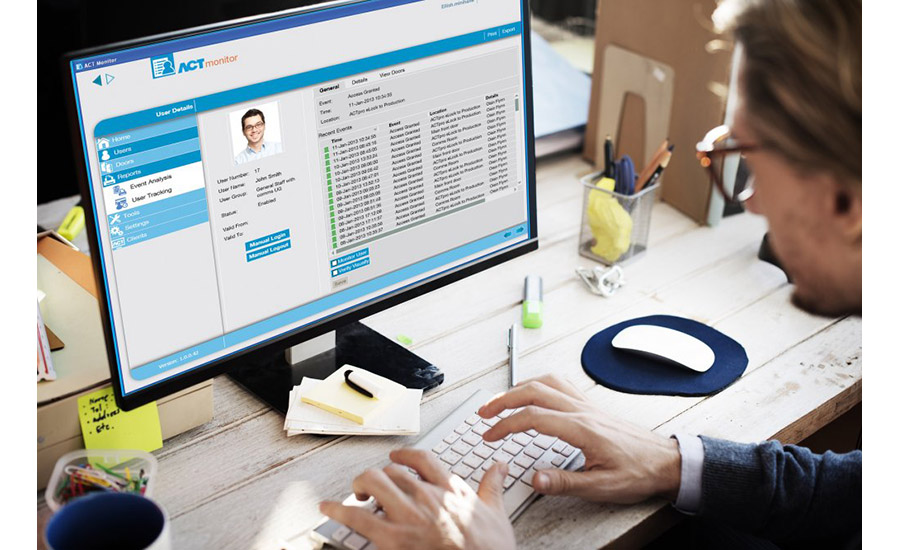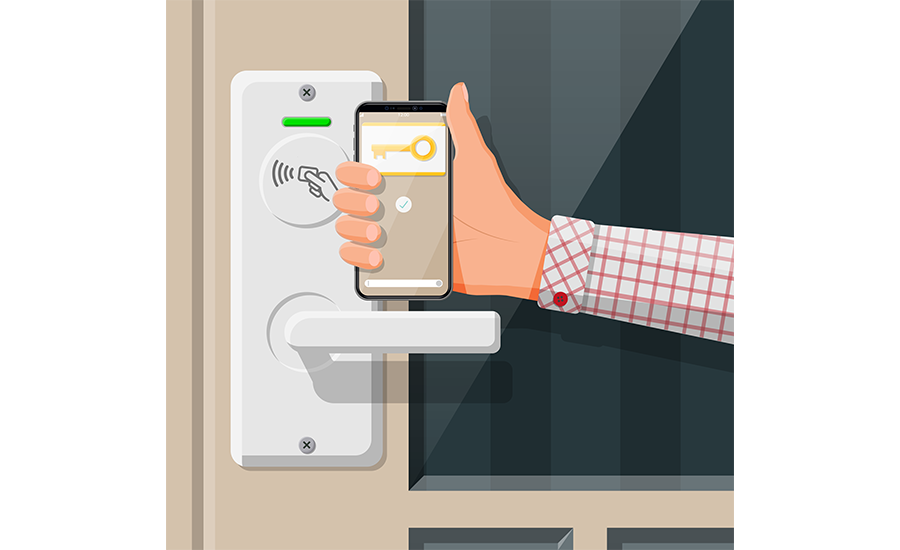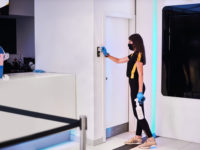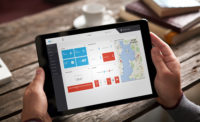On the growing menu of cloud-based services that integrators can offer their customers, managed access control is currently the most popular entrée of the day. While the service has been around for years, and has always been a great way for integrators and dealers to align themselves more closely with their customers, a convergence of trends is driving more interest in managed access control. Increased cloud acceptance, more manufacturer offerings, mobile technology, concern about cybersecurity, and higher customer demand for remote connection are all contributing to the trend.
“There’s never been a better time to provide managed access control,” says Eric Widlitz, vice president product management, ACRE, Las Vegas. “With the advances in threats like cyber-attacks, guarding your infrastructure has never been more critical. Handing off managed access control to your service provider delivers a unique level of data security. Additionally, the attractiveness of managed access control is that everything is controlled off-site by a team of qualified experts. This method means the client can be guaranteed that their data is secure and concentrate on their most critical business functions without worrying about their security infrastructure.”
As a service category, managed access control falls under “managed services/cloud-based services,” which are currently offered by 56 percent of integrator/dealer respondents, according to the SDM Industry Forecast.
Among integrators that provide their customers with managed/cloud-based services, managed access control tops the list, offered by 72 percent of respondents, with 46 percent of respondents planning to offer it in the near future.
For security dealers and integrators, expanding their managed access control services is part of growing their recurring monthly revenue — a way to stabilize income, increase ROI, and keep customers close.
“A managed service is sold as a subscription, which is great for an integrator to get recurring revenue they can rely on,” says Mark Allen, general manager premises, Identiv, Santa Ana, Calif. “Another large benefit for an integrator is to be able to log in to a customer site and solve a problem while on their next job, therefore increasing their customer service levels.”
There are big benefits for customers, too, especially small- to mid-sized businesses that may struggle with in-house expertise or a big upfront investment for an on-premise access control system.
“Overall, cloud-based access control is a highly cost-effective solution for those looking to increase security without the complexity and overhead cost,” Widlitz says. ”As more workforces look to expand the remote nature of work, we expect adoption to continue to rise.”
Allen agrees. “There is a lot of money to be saved if a customer does not have to maintain ‘bare metal’ in their buildings,” Allen adds. “They do not have to pay their integrators to upgrade to the latest operating system, latest database, and latest version of the application. This translates to big savings, and customers can use that money to buy more feature sets and improve security.”

Access control and video management in the cloud, such as ACRE’s ACT365, allows users to update or remove user permissions, view cameras, or open a door from any internet connected device, including PC, tablet, or smartphone. // IMAGE COURTESY OF ACRE
For end users, managed access control is becoming more mainstream for two key reasons: more traditional manufacturers buying into new technology, and the pandemic driving demand for systems that are simpler to manage remotely and offer greater flexibility, says Dave Sweeney, general manager of Advantech, a Security-Net member integrator based in Dover, Del. “We are seeing mainly customers that don’t have the large infrastructure to support a traditional PACS (physical access control systems) architecture as the ones who are investing in managed access,” he says. “This also includes decentralized businesses, such as customers with many geographic locations or many remote staff members. These decentralized businesses find a lot of value from managed and hosted offerings compared to the rigid confines of an on-premise solution.”
Cloud as a Game Changer
Managed access control — in which a security integrator actually takes on the day-to-day management of a customer’s access control system — has been available to customers for at least the last 15 years, launched by the new availability of cloud companies in the early 2000s, says Steve Van Till, founder and CEO of Brivo, Bethesda, Md. The term “hosted access control” — when the integrator simply hosts the solution and collects a fee, with the end user still managing some or all of the daily tasks of running the system — is often used interchangeably with managed access control, although they are two very different systems, he adds. “Although you can deliver the service layer better on the cloud, you can do it both ways, and dealers have been doing it for years.”
However, growing acceptance of cloud technology in the security industry has been a game changer for managed access control. “While the security industry has been slow to embrace the cloud, we’re seeing the need to create an ecosystem in which customers are convinced that a cloud-based security solution is both secure and cost effective,” says Sheeladitya Karmakar, global offering leader, Honeywell Commercial Security, Atlanta. “Cloud abilities allow managed access controls to function, and cloud-based access control is becoming a go-to solution for buildings. More facilities managers are demanding high levels of insight and control from anywhere at any time. As organizations expand, they may include satellite sites and remote work locations, which also need access control. A hybrid cloud approach helps them achieve this without spending on personnel and additional hardware costs.”
Increased customer interest in managed access control is part of the overall growth of cloud services in general, Van Till says. “Cloud services as a tech layer are a great enabler of managed services as a concierge offering,” he says. ”More of the people who will offer it will find that cloud is a better infrastructure than any on-premise technologies.”
How the Pandemic Nurtured the Growth of Managed Access Control

Since so many businesses have transitioned to remote work, employees are using more networks to access facilities remotely, creating more access points for potential cybersecurity intrusion. // MIXETTO/E+ VIA GETTY IMAGES
The global COVID-19 pandemic highlighted the need for managed access control, whether a customer’s facility was sitting empty, or an administrator had to isolate for 10 days after contracting the illness, says Dave Sweeney of Advantech. “It’s not just about the office being open, but it’s also about the reliability of the workforce to work,” he said. “If the access control administrator all of a sudden had to be out of the office due to COVID-19 and you didn’t have a back-up plan, that company was up the creek. However, if that company has a managed access control system in place, with a partner that can provide remote administration support, they are afforded more stability when the workforce is less stable.”
Since so many businesses have transitioned to remote work, employees are using more networks to access facilities remotely, creating more access points for potential cybersecurity intrusion, says Sheeladitya Karmakar of Honeywell Commercial Security. And because many companies have experienced large staff turnover due to the “Great Resignation,” it’s likely that many of those contractors and former employees still have corporate access cards — making it a priority for facility managers to bolster the security and remote capabilities of their building’s access controls.
The pandemic also jump-started a shift in managed access controls to be a more frictionless and touchless experience, Karmakar says. “Access controls were a manual process for years. For example, security personnel often had to maintain an entry log in which people would fill out a paper form to receive an access card. While a cumbersome process overall, it also had major pain points: when someone forgot to return an access card, it posed a potential security risk. Today, through digital solutions, the process is becoming much more streamlined, not only for facilities but also for end users.”
The pandemic also accelerated the race to the cloud in access control and just about every industry as workers went fully remote, she adds. “Building and facility managers need the flexibility to monitor and manage their buildings remotely. Cloud-based access control offers a seamless and holistic view any time, from anywhere, and streamlines operations by allowing professionals to make informed decisions.”
The COVID-19 pandemic also took a chunk out of many business’s bottom lines, making it challenging for them to get capital expenditure, says Mark Allen of Identiv. “Most industries were struggling with keeping their employees and businesses going, so a ‘pay-as-you-go’ model was much more achievable,” he said. “We saw growth in contact-tracing applications, face mask awareness, and other features to help customers manage the ever-changing environment.”
Steve Van Till of Brivo says, “Interest went up because more people felt the need for remote management, and managed access control was one strategy for achieving that. People who would normally administer the office and security were not there to the extent they needed to do anything, so they needed to do it remotely.”
Widlitz of ACRE says, “With cloud-based access control, users can manage multiple sites from a unified interface without the added expense of local servers and IT resources. These systems also tend to be very intuitive, so it is easy for teams to learn without investing in significant training.”
Although the use of managed access control is industry agnostic, there are certain market segments that are a natural fit for the service. Van Till notes that it’s especially popular for property owners and management companies with widely distributed property locations, and the ability to offload handling issues on evenings and weekends — as well as some transfer of liability around issues of access permissions.
Anthony DiCato, business development sales engineer lead for Netronix Integration, an integrator based in San Jose, Calif., provides managed access control services to Bay Area-based businesses like big tech, Fortune 100 companies, and government entities, where much of the demand for managed access control came as a result of the global pandemic. “Over the last two years, there has been higher demand for integration, and we’ve seen more push for visitor management,” he says. “While there is some cloud access out there, we also offer on-prem services through Splan Visitor and PDF Solutions Inc., which we integrate into major access control systems.”
The RMR Benefit
For security integrators, managed access control is an opportunity to build recurring monthly revenue (RMR), deliver strong ROI to the company, and retain a strong partnership with customers.
“Through managed services, such as cloud-based access control, integrators are able to take a service-based approach to an organization’s access control system to ensure maximum uptime, deliver important and ongoing updates, and provide business owners with a cost-effective way to provide the kind of security oversight they need,” Widlitz says. “With this technology, remote management and the ability to access information from anywhere, at any time, and on any device provides a huge selling point for integrators reaching a new audience of small- to medium-sized businesses.”
Sweeney agrees. “The benefit is going to be a partnership with your customer base and the opportunity to add value on a daily basis and in turn be compensated for that,” he says. “On the flip side, the challenge is going to be to build and maintain a workforce that can deliver this service.”
This can be a considerable roadblock for integrators, especially at a time when hiring and retention can be difficult, Van Till says. “The downside is it becomes a staffing challenge,” he says. “To do this, the integrator must provider 24/7 service, which is a big undertaking.”
On a more existential basis, integrators offering managed access control and other cloud-based services are faced with switching the business mindset from just offering a product to providing a service, Widlitz says. “There is a big difference between the two, and handling contracts with clients is much different than simply selling a product to a customer. SaaS is still relatively new to this industry, and won’t come without hesitation from those unfamiliar with it or the benefits it provides.”
But as customer demand for cloud-based services in general grows, integrators who fail to make the transition run the risk of becoming obsolete, Sweeney says. “This is going to have to evolve in order for integrators to be able to support the demands of the customer,” Sweeney says. “There will come a time where not having 24/7 support will be a deal breaker for a customer. Integrators are going to have to evolve or get out of the way.”
The future is enhanced service offerings, Sweeney adds. “The technology is there, so now the ball is in the systems integrators’ court to leverage that technology to provide white-glove services to our customers to add value. Managed service isn’t necessarily selling someone technology, but it’s about leveraging that technology to make someone’s life easier. So now we are going to see the offerings grow, and it’s important that integrators maintain that competitive advantage.”





